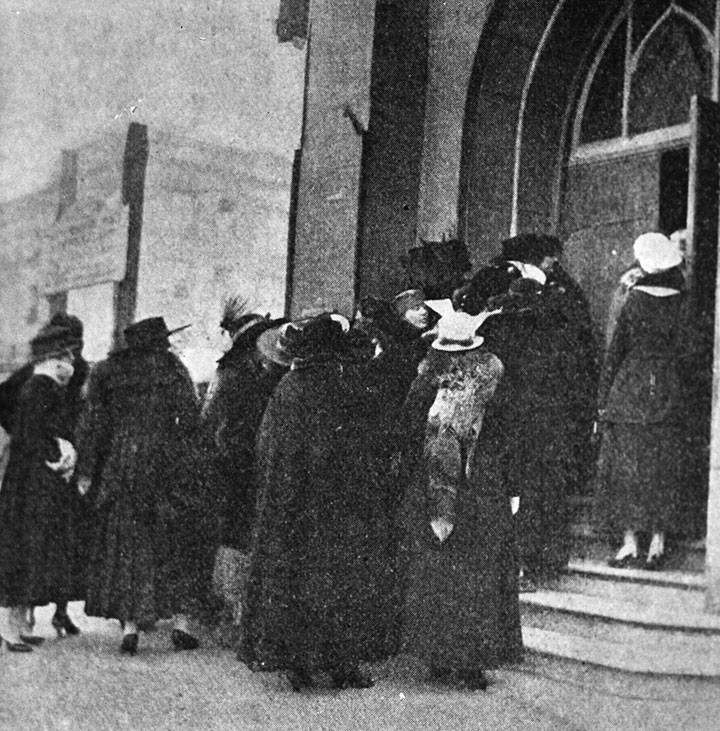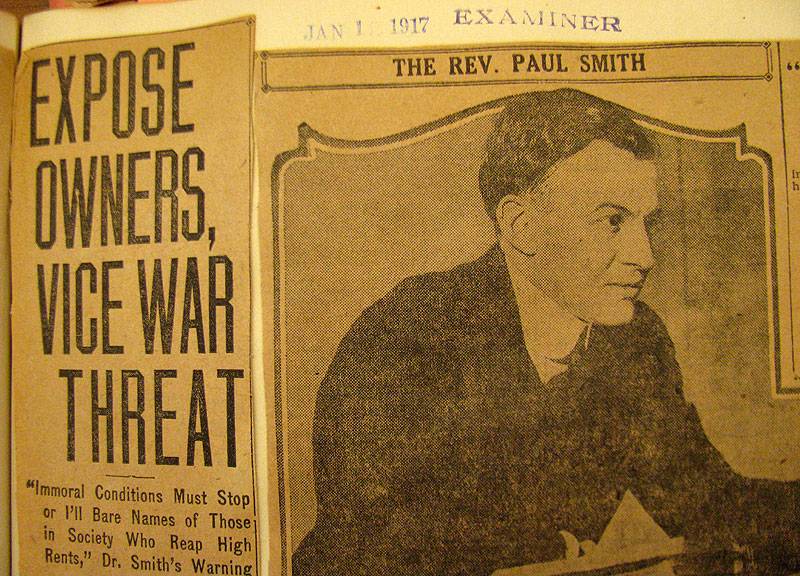Prostitute March 1917
Historical Essay
by Don MacLaren
Originally published in the February 1988 edition of The Tenderloin Times under the title "Years Ago in Neighborhood History: TL Morality Crusade Draws Prostitutes' Wrath"
On a January 1917 morning, more than 300 prostitutes dressed and perfumed in their finest, marched to the Central Methodist Church to confront Reverend Paul Smith, who had launched a campaign against sin and vice on the Barbary Coast. (It was reported that his sermons were so provocative that prostitutes flocked to the vicinity of his church after the services, where they found eagerly aroused customers).
Photo: San Francisco History Center, San Francisco Public Library
In the 19th century, the neighborhood was called St. Ann's Valley, a fashionable entertainment district of theaters, cafes, and restaurants. By the turn of the century, it became know as the uptown Tenderloin. Some sources say the name "Tenderloin" referred to the high-priced cut of steak the police could afford if they took bribes to overlook the vice in the neighborhood.
The following is an account of how several hundred prostitutes organized against a minister's morality crusade in the Tenderloin in the early 1900s.
"The most dramatic incident of my life," was how Reverend Paul Smith, leader of an anti-prostitution reform movement in the Tenderloin, described his confrontation with 300 prostitutes in his church the morning of January 25, 1917. In that meeting, Smith was shocked when the women informed him that most of them were mothers who had turned to prostitution because it was the only way to support their children.
Reverend Smith, pastor of Central Methodist church at O'Farrell and Leavenworth streets, had begun his anti-prostitution crusade because he was outraged at the sight of young women providing "entertainment" in the cafes, bars, and streets around his church. He claimed his church was surrounded by brothels and the men in his congregation were being corrupted on their way to and from church and their rooms at the YMCA.
Newspapers of the times quoted prostitutes as saying that Smith's fiery sermons condemning the world's oldest profession did more to spark the flames of curiosity in the men of his congregation than any Tenderloin prostitutes could do.
Smith's reform movement was the first the Tenderloin had seen. Making a tour of the local night life scene, he was amazed at how blatant prostitution was in the cafes. He noted that shortly after sitting down at a table, he was approached by two women who soon suggested more intimate surroundings – perhaps drawing the drapes, or moving to a booth where a bed was conveniently located nearby.
As Smith continued preaching against vice and sin, he garnered a following of thousands. They planned to hold a mass meeting at the church on the afternoon of January 25, 1917, to decide how they were going to wipe out prostitution in the Tenderloin.
Before the mass meeting, Smith got a phone call from Mrs. M. R. "Reggie" Gamble, who ran a "parlor house" on Mason Street. She told him she was one of the people Smith's crusade had been directed against – prostitutes and their associates. Gamble requested an audience with Smith in his church to discuss the problem of vice and how best to deal with it.
Smith agreed, and on the morning of the same day when the mass reform meeting was planned, Gamble arrived along with an entourage of 300 prostitutes she had organized to accompany her.
They demanded to know how Smith thought the women would support themselves after the Tenderloin was cleansed of prostitution. Smith replied that the women should be able to support themselves and their families on $10 a week by working as domestics. They told him they couldn't survive on those wages because a pair of shoes alone cost $10.
This was enough to give him pause, but he was truly shocked to learn that three-fourths of these women worked as prostitutes in order to earn enough to support their children. The only other jobs open to them couldn't meet the costs of raising a family, they told him.
Gamble told Smith that it was men who were to blame for the prostitutes' lot in life. It was men who sought out prostitutes and other men who profited from their trade, Gamble said. Thus, the 300 prostitutes claimed they were victims of a system they were not responsible for.
Gamble contrasted Smith, who took no interest in aiding prostitutes in their plight, with Jesus, who had befriended Mary Magdalene in the Bible. She insisted the crusaders get to the root of vice and prostitution and provide for the victims of the social system, the prostitutes.
Reverend Paul Smith in the San Francisco Examiner, Jan. 1, 1917.
Stunned, Smith promised to fight for a minimum wage law and to look to the needs of the women who were crowded into his church. The women were not convinced of his sincerity, however, and walked out on him. Smith eventually did go on to work for a minimum wage law, but he was as passionate as ever to stop prostitution.
That afternoon, before a crowd of 7,000, Smith and other reformers outlined steps to be taken in their battle against prostitution. Among these were the enforcement of existing laws and the appointment of a vice committee to investigate and make recommendations as to how prostitution and gambling could best be suppressed.
To strengthen his cause, Smith embarrassed Mayor Rolph and District Attorney Fickert into joining in his crusade by accusing them of acquiescing to vice and sin in the Tenderloin.
Including these public officials in his movement proved very effective, because in late January of 1917, new laws were passed that closed 208 cafes, dance halls and "parlor houses" in the Tenderloin. In February, raids closed every brothel in the Tenderloin and the Barbary Coast. Most of the prostitutes had to flee the Tenderloin and most found themselves struggling more than ever to support their children.


